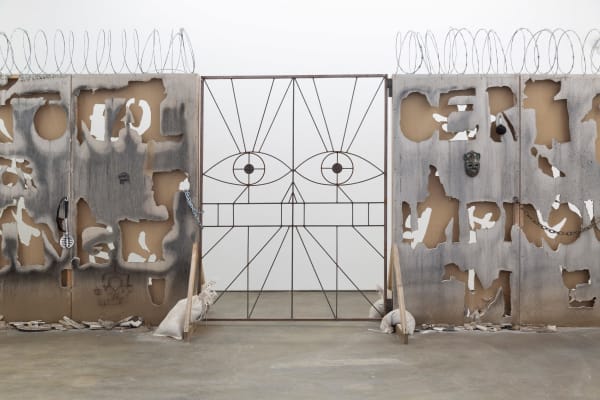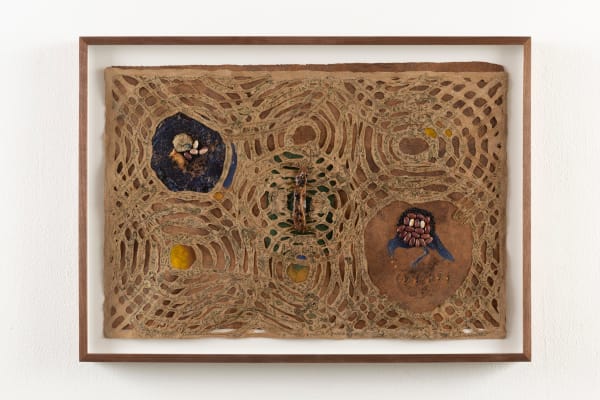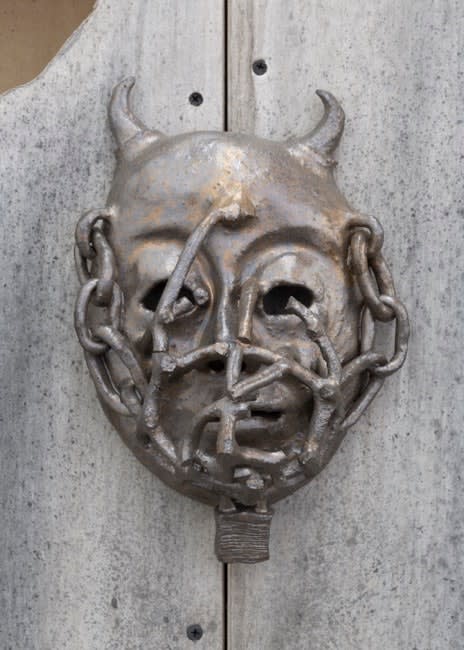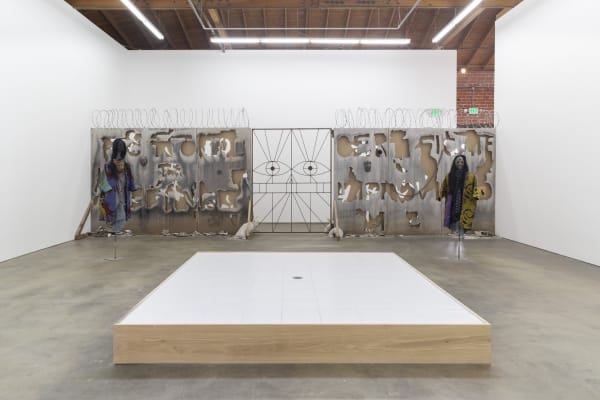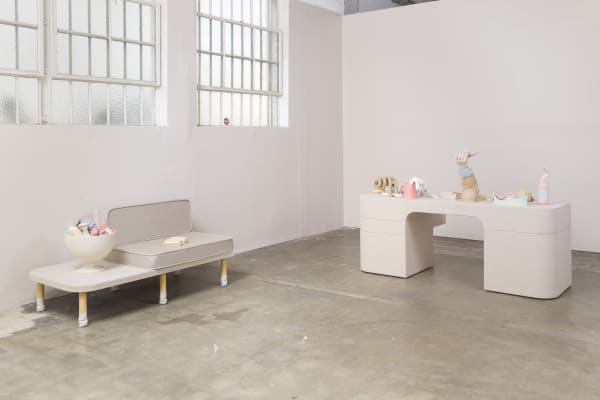Candice Lin: Meaningless Squiggles
François Ghebaly is proud to present Meaningless Squiggles, Candice Lin’s fifth solo exhibition with the gallery. The exhibition takes a panoramic view of Lin’s recent projects, drawing on her expanded research into subjects ranging from Chinese “coolie” labor in the Caribbean, James Baldwin’s travels outside the U.S., plants that heal and hurt, disciplinary masks used as Medieval European public shaming devices and their formal similarity to slave torture devices, and John Searle’s writings on artificial intelligence. Seemingly disparate, these topics are connected by a consideration of the entangled movements of people, plants, viruses and other species. Lin uses these histories of migration and control to think about how ideas of toxicity, contamination, humanness and usefulness are categories that become racialized, implemented and then blurred through State and social disciplinary processes. What arises from these far flung subjects is a practice restlessly and persistently investigating material pasts, tracing objects and their histories to open up discourses around race, value and the economies of dehumanization.
The exhibition contains a system of circulating fluids. Upon entering the space, viewers encounter a human silhouette of tobacco leaves lying on a table filled with cement. On the figure’s abdomen lies a glass distiller simmering a tincture of poppy, sugar, tobacco and tea. Legacies of colonialism, violence and forced labor shadow these materials, spanning the Opium Wars in China to the exacerbation of often forced Asian contract laborers, known as the “coolie” trade, where hundreds of thousands of Chinese laborers were brought to work the plantations and cement and brick factories of the Caribbean and parts of the U.S. in the 19th century. The distillate rises from the prostrate figure, gets pumped through a series of tubes traversing the walls and rafters and enters another room where it slowly drips onto a white tiled platform adorned only with a metal drain. The composite liquid of distilled water and plant volatiles slips through the drain, falling out of sight with barely a trace of its forced transit.
An extended hallway illuminated with magenta light draws viewers towards an exposed foundation of false stones. Emitting from the rocks is the voice of the poet Renee Gladman, whose poem speaks to the charged and interwoven legacies of Lin’s materials. The hallway walls are illuminated from a window created by an inset aquarium tank in which microbes brew a kombucha of rose, hibiscus and poppy. A decrepit institutional door leads into an antiseptically white space, punctuated by the drip-drip of the plant distillate and flanked by two masked figures standing watch. The space is further enclosed by a razor wire-topped wall that gives the exhibition its title.
The wall, made of sheetrock covered with bone black pigment, growing black mold and affixed with research materials and objects, is inscribed with text by American philosopher John Searle, who has used the “meaningless squiggles” of written Chinese in thought experiments about artificial intelligence. Linking the Chinese language to the inability to decipher between a robot and a human, Searle continues the Techn-Orientalist metaphors that play into a longer history of Western dehumanization of Asian labor and consciousness. With an ironic twist, Lin passes Searle’s words through an automated English to Chinese translation—a kind of A.I.—resulting in an awkward but legible Mandarin phrasing. The characters were then written by Lin’s father and cut out of the walls by her, speaking to the presence of absence in her experience as a first-generation immigrant negotiating between cultural loss and assimilation. A welded iron gate stands closed, allowing visitors to see to the other side but blocking passage.
Throughout the exhibition, as more broadly in Lin’s practice, many histories intertwine in a kaleidoscopic process of unearthing, remembering and memorializing. The works, in the words of feminist literary scholar Saidya Hartman, attempt “to imagine what cannot be verified…to reckon with precarious lives which are only visible in the moment of their disappearance.” ¹
Candice Lin was born in 1979 in Concord, Massachusetts, and has lived and worked in Los Angeles since 2005. Her recent solo exhibitions include the exhibition cycle A Hard White Body at Bétonsalon, Paris; Portikus, Frankfurt; and the Logan Center for the Arts, University of Chicago, as well as solo exhibitions at Gasworks, London; 18th Street Art Center, Los Angeles; and Human Resources, Los Angeles. Her work is currently on view in group shows around the world including Para Site, Hong Kong; ICA London; Ballroom Marfa and Walker Art Center, Minneapolis. Lin has been included in prominent recent group exhibitions including the 2018 Taipei Biennale; the 2018 Athens Biennale; Made in L.A. 2018, Hammer Museum, Los Angeles; New Museum, New York; Sharjah Biennial 2017, Beirut; and SculptureCenter, New York. She is the recipient of several residencies, grants and fellowships, including the Louis Comfort Tiffany Award (2017), the Davidoff Art Residency (2018) and Smithsonian Artist Research Fellowship (2009). In 2018 she was appointed to the faculty of the University of California Los Angeles Department of Art.
1 Saidiya Hartman, “Venus in Two Acts,” Small Axe, No. 26, Vol. 12 (June 2008): 12.
-
 Candice Lin, A Rose Window, 2019
Candice Lin, A Rose Window, 2019 -
 Candice Lin, A Robot Spoke What My Father Wrote, 2019
Candice Lin, A Robot Spoke What My Father Wrote, 2019 -
 Candice Lin, Datura metel, 2018
Candice Lin, Datura metel, 2018 -
 Candice Lin, Exposed Foundation, 2019
Candice Lin, Exposed Foundation, 2019 -
 Candice Lin, Mathematics of a Day, 2019
Candice Lin, Mathematics of a Day, 2019 -
 Candice Lin, Flag of Traded Colors, 2019
Candice Lin, Flag of Traded Colors, 2019 -
 Candice Lin, La Charada China (Tobacco Version), 2019
Candice Lin, La Charada China (Tobacco Version), 2019 -
 Candice Lin, Papaver Somniferum (Tapestry), 2019
Candice Lin, Papaver Somniferum (Tapestry), 2019 -
 Candice Lin, Circles of Will, 2019
Candice Lin, Circles of Will, 2019 -
 Candice Lin, Witness (Blue Version), 2019
Candice Lin, Witness (Blue Version), 2019 -
 Candice Lin, Witness (Yellow Version), 2019
Candice Lin, Witness (Yellow Version), 2019 -
 Candice Lin, Scold’s Bridle (Animal), 2019
Candice Lin, Scold’s Bridle (Animal), 2019 -
 Candice Lin, Scold’s Bridle (Muzzle), 2019
Candice Lin, Scold’s Bridle (Muzzle), 2019 -
 Candice Lin, A Robot Spoke What My Father Wrote, 2019
Candice Lin, A Robot Spoke What My Father Wrote, 2019



